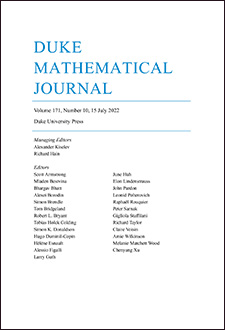Abstract
Associated with each body $K$ in Euclidean $n$-space $\mathbb {R}\sp n$ is an ellipsoid $\Gamma\sb 2K$ called the Legendre ellipsoid of $K$. It can be defined as the unique ellipsoid centered at the body's center of mass such that the ellipsoid's moment of inertia about any axis passing through the center of mass is the same as that of the body.
In an earlier paper the authors showed that corresponding to each convex body $K\subset\mathbb {R}\sp n$ is a new ellipsoid $\Gamma\sb {-2}K$ that is in some sense dual to the Legendre ellipsoid. The Legendre ellipsoid is an object of the dual Brunn-Minkowski theory, while the new ellipsoid $\Gamma\sb {-2}K$ is the corresponding object of the Brunn-Minkowski theory.
The present paper has two aims. The first is to show that the domain of $\Gamma\sb {-2}$ can be extended to star-shaped sets. The second is to prove that the following relationship exists between the two ellipsoids: If $K$ is a star-shaped set, then
$\Gamma\sb {-2}K\subset\Gamma\sb 2K$
with equality if and only if $K$ is an ellipsoid centered at the origin. This inclusion is the geometric analogue of one of the basic inequalities of information theory–the Cramer-Rao inequality.
Citation
Erwin Lutwak. Deane Yang. Gaoyong Zhang. "The Cramer-Rao inequality for star bodies." Duke Math. J. 112 (1) 59 - 81, 15 March 2002. https://doi.org/10.1215/S0012-9074-02-11212-5
Information





